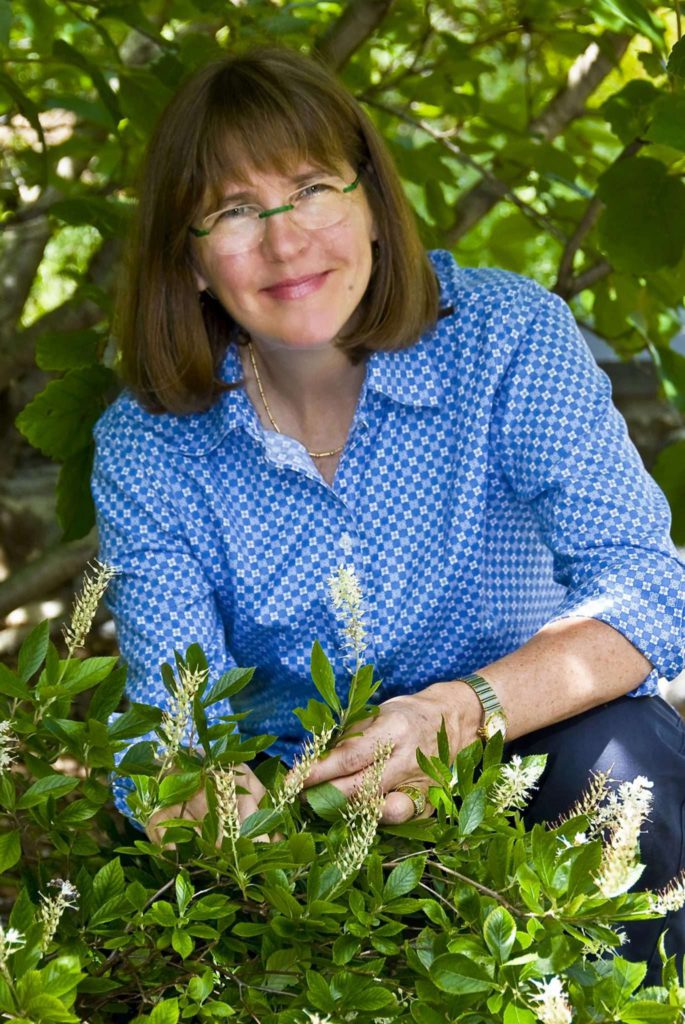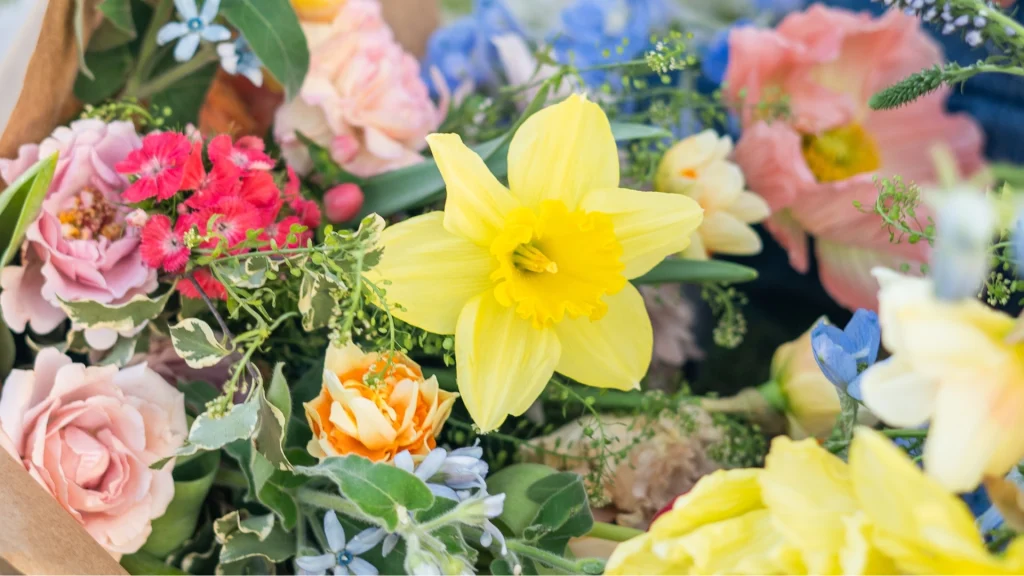
Spring brings an undeniable energy to floral design, and few flowers embody that seasonal shift like daffodils. Their bright, cheerful faces are a must-have for floral professionals, adding instant warmth and vibrancy to any arrangement. After reviewing the Mayesh Flower Library, I compiled a collection of daffodil varieties of all shapes, sizes, petal counts, and colors. Whether designing wedding florals, event installations, or seasonal retail arrangements, I hope this breakdown will help you choose the right daffodils for your arrangements!
Daffodils Belong in Every Florist’s Springtime Cooler
Daffodils, known botanically as narcissus, are versatile blooms that bring texture, movement, and a pop of color to any floral design. Their long vase life, sturdy stems, and seasonal appeal make them a must-have for spring arrangements. Available in classic trumpet, double, cupped, and tazetta forms, they offer a range of silhouettes and color palettes beyond bright yellow. Whether as focal flowers or delicate accents, daffodils add dimension, freshness, and a touch of spring nostalgia.
You might say, “HEY! Where are the paperwhites?!” once you get to the end of this list.
Fun fact: Daffodils are a specific type of narcissus, but NOT all narcissus flowers are daffodils. Let me explain: all daffodils belong to the narcissus genus, which includes a variety of flowers, such as daffodils, jonquils, and paperwhites. Daffodils typically have a large, trumpet-shaped corona, while other narcissus species may have smaller cups, multiple blooms per stem, or different growth habits. With over 40+ daffodil varieties featured below, we think you’re well covered, even without paperwhites!
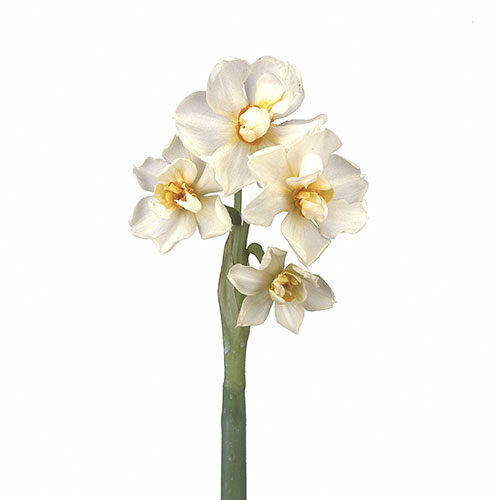 Daffodil Abba White/YellowShape: Modified Tazetta Daffodil Abba White/YellowShape: Modified Tazetta Vase Life: 5-7 days Petal Count: 6 per bloom Description: A striking variety with bright white petals and a deep golden-yellow trumpet. |  Daffodil Apotheose YellowShape: Double Daffodil Apotheose YellowShape: DoubleVase Life: 5-7 days Petal Count: 6 per bloom Description: A vibrant yellow daffodil with a classic trumpet shape and slightly ruffled edges, adding a cheerful touch to any arrangement. | 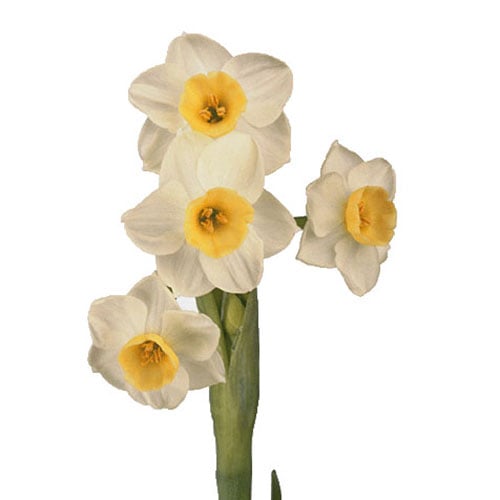 Daffodil Avalanche CreamShape: Tazetta (Cluster-Flowered) Daffodil Avalanche CreamShape: Tazetta (Cluster-Flowered)Vase Life: 5-7 days Petal Count: 6 per bloom Description: A multi-flowered daffodil produces 5-7 small creamy-white blooms per stem, each with a soft yellow cup. | 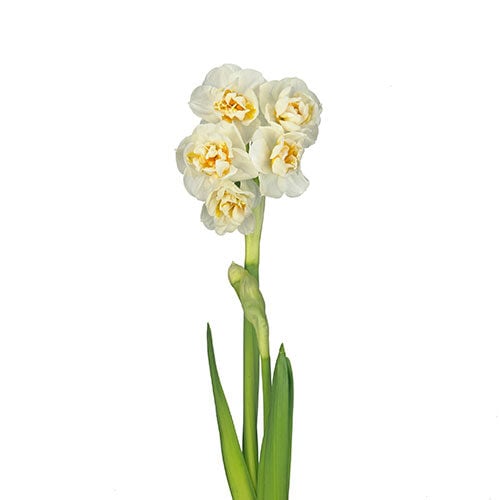 Daffodil Bridal Crown WhiteShape: Modified Tazetta (Cluster-Flowered) Daffodil Bridal Crown WhiteShape: Modified Tazetta (Cluster-Flowered)Vase Life: 7-10 days Petal Count: 12+ per bloom Description: A double-flowered daffodil with clusters of creamy-white blooms and soft golden centers, known for its intense fragrance and elegant, ruffled petals. |
 Daffodil Bright Paradise YellowShape: Double Daffodil Bright Paradise YellowShape: DoubleVase Life: 5-7 days Petal Count: 12+ per bloom Description: A double-flowered daffodil with layers of golden-yellow petals and a textured, ruffled center, adding volume and vibrancy. | 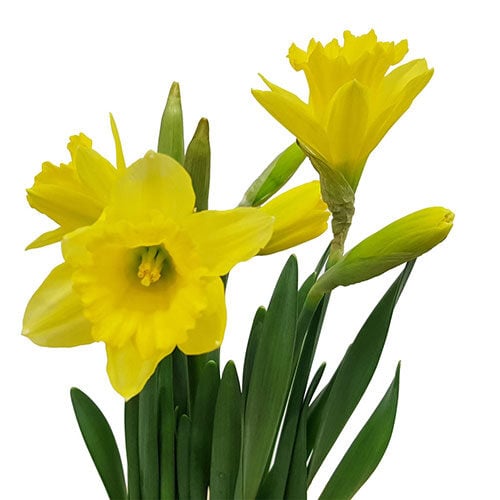 Daffodil Carlton YellowShape: Classic Trumpet Daffodil Carlton YellowShape: Classic TrumpetVase Life: 5-7 days Petal Count: 6 per bloom Description: A classic yellow daffodil with soft golden petals surrounding a large, frilly, deep-yellow cup. | 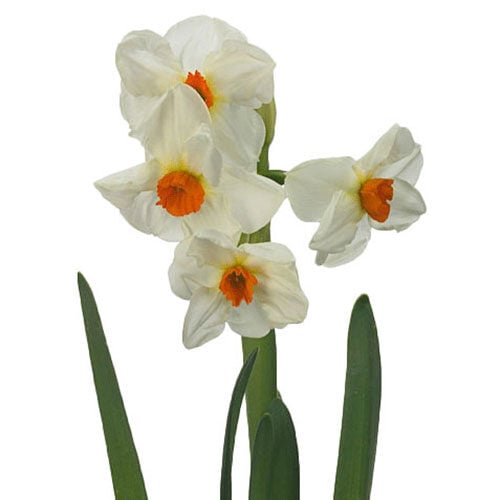 Daffodil Cragford YellowShape: Tazetta (Cluster-Flowered) Daffodil Cragford YellowShape: Tazetta (Cluster-Flowered)Vase Life: 5-7 days Petal Count: 6 per bloom Description: A multi-flowered daffodil producing up to six blooms per stem, with pure white petals and a small, vibrant orange cup. | 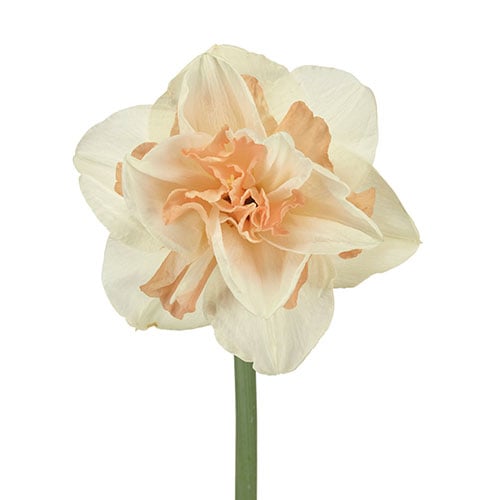 Daffodil Delnashaugh Cream/PeachShape: Double Daffodil Delnashaugh Cream/PeachShape: DoubleVase Life: 5-6 days Petal Count: 12+ per bloom Description: A luxurious double daffodil with creamy white outer petals and a soft peach-hued ruffled center, resembling a delicate rose. |
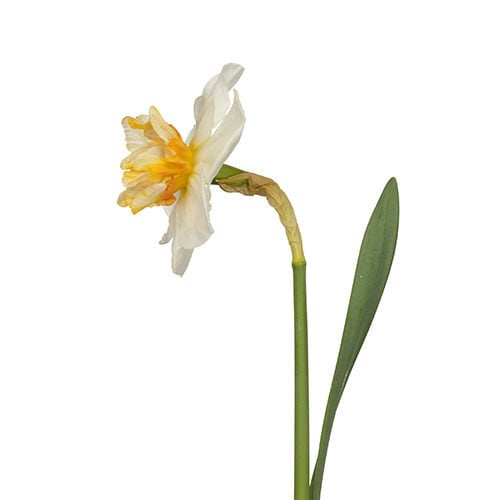 Daffodil Delta White/YellowShape: Cup Daffodil Delta White/YellowShape: CupVase Life: 5-7 days Petal Count: 6 per bloom Description: A bold bi-color daffodil with white outer petals and a large, ruffled yellow trumpet. | 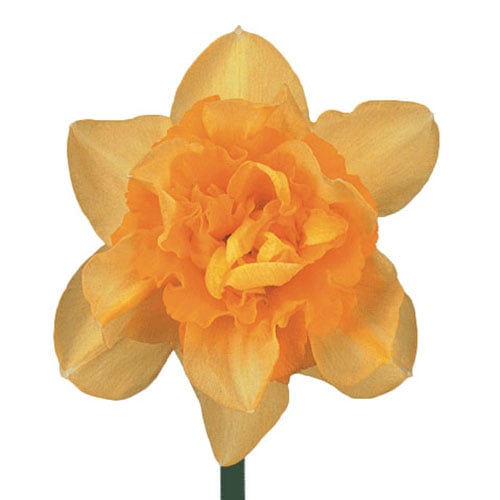 Daffodil Dick Wilden YellowShape: Double Daffodil Dick Wilden YellowShape: DoubleVase Life: 5-6 days Petal Count: 12+ per bloom Description: A classic double daffodil with layers of golden-yellow petals surrounding a frilly, ruffled cup. Its full, showy blooms adds richness and texture. | 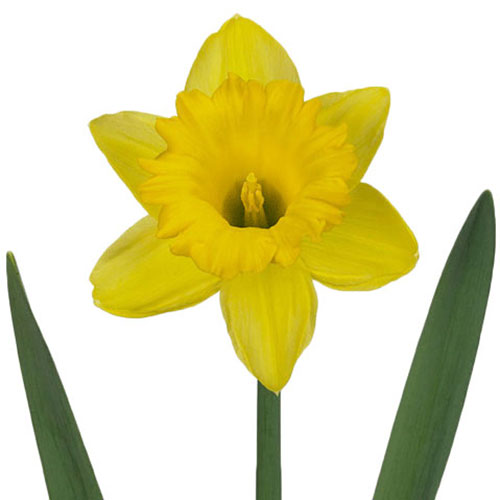 Daffodil Dutch Master YellowShape: Trumpet Daffodil Dutch Master YellowShape: TrumpetVase Life: 5-7 days Petal Count: 6 per bloom Description: A classic trumpet daffodil with large, golden-yellow blooms. Its sturdy stems and bold color make it a top choice for floral arrangements. | 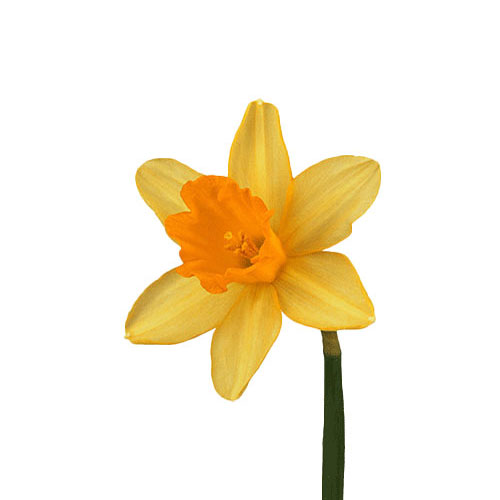 Daffodil Fortune YellowShape: Trumpet Daffodil Fortune YellowShape: TrumpetVase Life: 5-7 days Petal Count: 6 per bloom Description: Striking contrast with bold two-tone daffodils with golden-yellow petals and an orange-rimmed cup. |
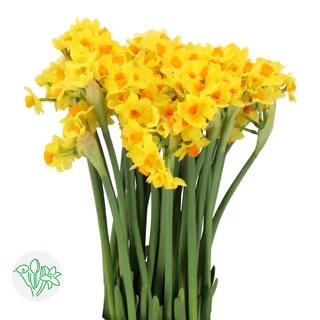 Daffodil Grand Soleil DorShape: Tazetta (Cluster-Flowered) Daffodil Grand Soleil DorShape: Tazetta (Cluster-Flowered)Vase Life: 7-10 days Petal Count: 6 per bloom Description: A multi-flowered tazetta daffodil with clusters of golden-yellow blooms and deep orange cups. | 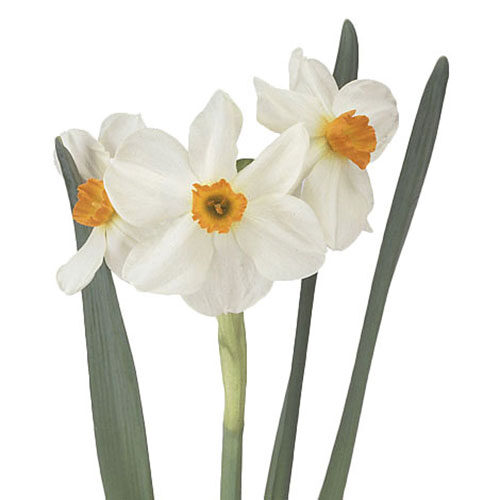 Daffodil Geranium White/YellowShape: Tazetta (Cluster-Flowered) Daffodil Geranium White/YellowShape: Tazetta (Cluster-Flowered)Vase Life: 7-10 days Petal Count: 6 per bloom Description: A multi-flowered tazetta daffodil that produces 2-6 small, creamy-white blooms per stem, each featuring a bright orange cup. | 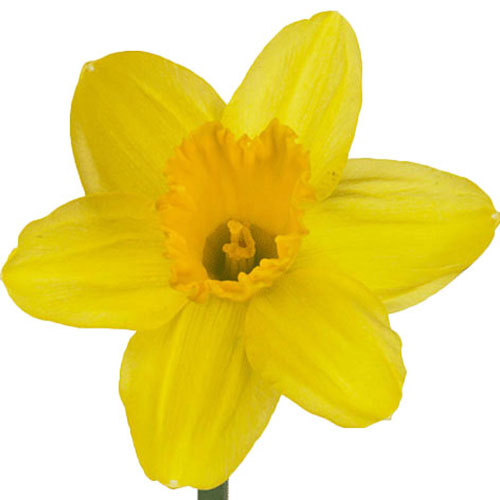 Daffodil Gigantic Star YellowShape: Trumpet Daffodil Gigantic Star YellowShape: TrumpetVase Life: 5-7 days Petal Count: 6 per bloom Description: A giant yellow daffodil with broad, overlapping petals and a large, open-faced trumpet. | 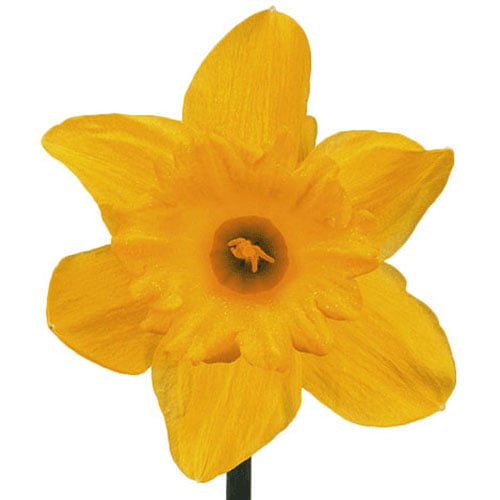 Daffodil Golden Harvest YellowShape: Trumpet Daffodil Golden Harvest YellowShape: TrumpetVase Life: 5-7 days Petal Count: 6 per bloom Description: A classic trumpet daffodil with bold, golden-yellow petals and a slightly ruffled trumpet with a strong stem. |
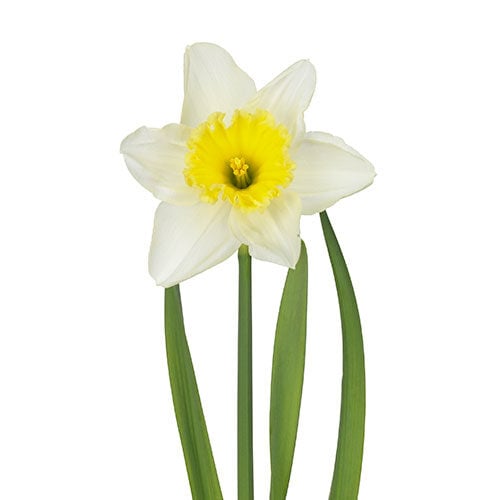 Daffodil Ice Follies CreamShape: Trumpet Daffodil Ice Follies CreamShape: TrumpetVase Life: 5-7 days Petal Count: 6 per bloom Description: A large-cupped daffodil with silvery-white petals and a broad, flattened lemon-yellow cup that fades to creamy white as it matures. | 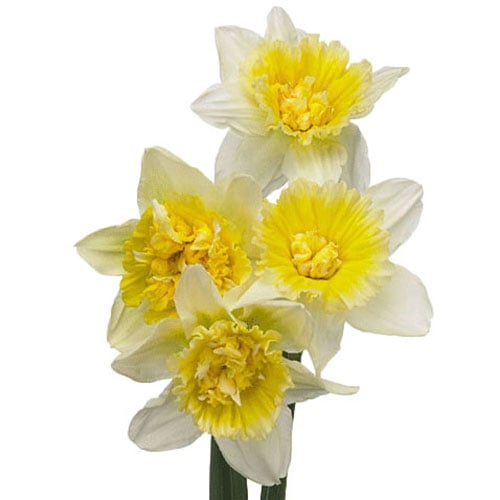 Daffodil Ice King Pale YellowShape: Double Daffodil Ice King Pale YellowShape: DoubleVase Life: 5-6 days Petal Count: +12 per bloom Description: A double-flowered daffodil with layers of creamy, frilled yellow center, creating a full, ruffled appearance. | 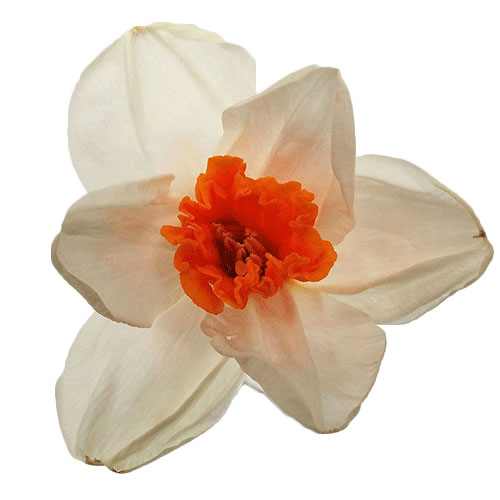 Daffodil Johann Strauss Cream/OrangeShape: Large-Cupped Daffodil Johann Strauss Cream/OrangeShape: Large-CuppedVase Life: 5-7 days Petal Count: 6 per bloom Description: Has creamy petals and a rich, orange-rimmed cup. | 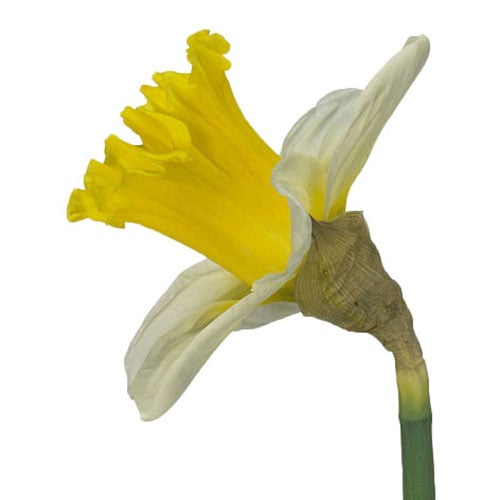 Daffodil Las Vegas White/YellowShape: Trumpet Daffodil Las Vegas White/YellowShape: TrumpetVase Life: 5-7 days Petal Count: 6 per bloom Description: A striking bi-color daffodil with a large, frilly lemon-yellow trumpet and creamy white petals. |
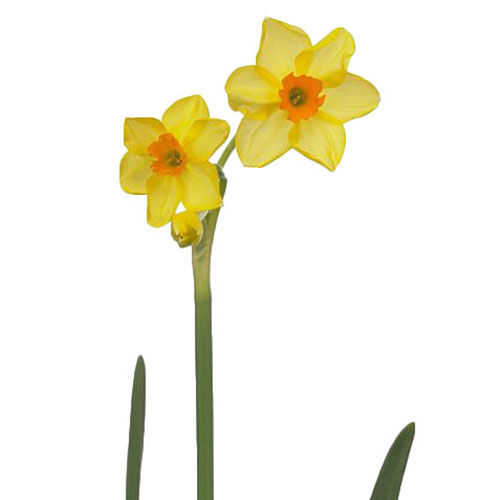 Daffodil Martinette Yellow/OrangeShape: Tazetta (Cluster-Flowered) Daffodil Martinette Yellow/OrangeShape: Tazetta (Cluster-Flowered)Vase Life: 7-10 days Petal Count: 6 per bloom Description: A multi-flowered daffodil that produces several bright yellow blooms per stem, each with a bold orange cup. | 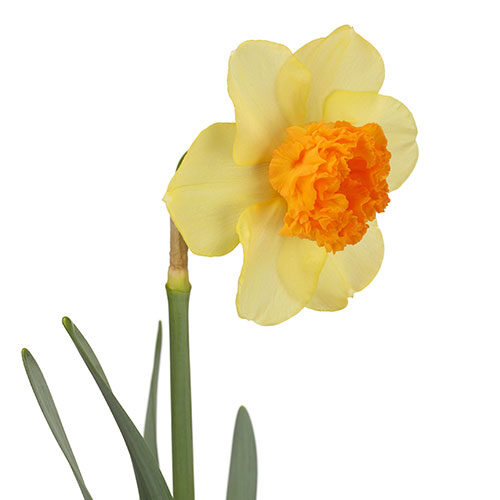 Daffodil Modern Art Cream/OrangeShape: Large Double Cup Daffodil Modern Art Cream/OrangeShape: Large Double CupVase Life: 5-7 days Petal Count: 6 per bloom Description: A ruffled, double daffodil with creamy outer petals and an apricot-orange center. | 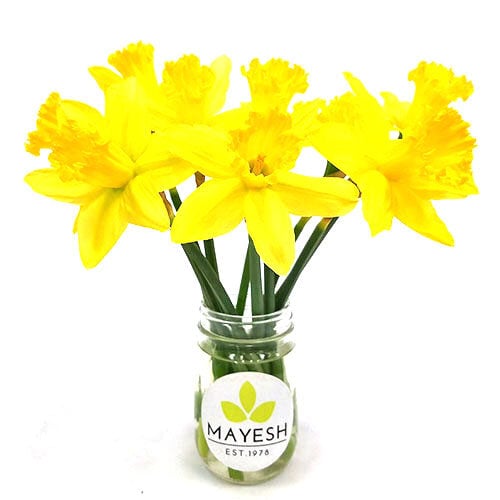 Daffodil Pencil YellowShape: Trumpet Daffodil Pencil YellowShape: TrumpetVase Life: 5-7 days Petal Count: 6 per bloom Description: A petite, slender daffodil with thin, delicate yellow petals and a small, darker trumpet. | 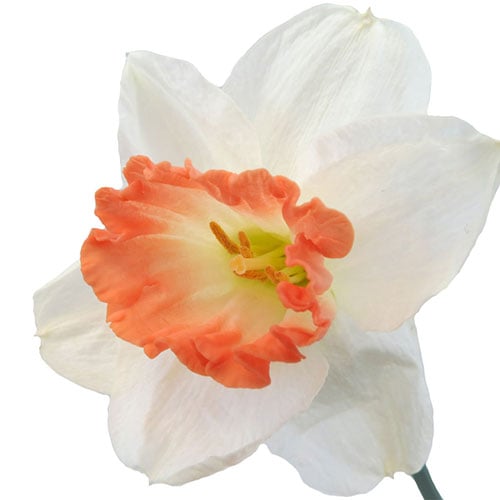 Daffodil Pink Charm Cream/PinkShape: Large-Cupped Daffodil Pink Charm Cream/PinkShape: Large-CuppedVase Life: 5-7 days Petal Count: 6 per bloom Description: A striking bicolor daffodil with creamy-white petals and a frilly, soft pink cup. |
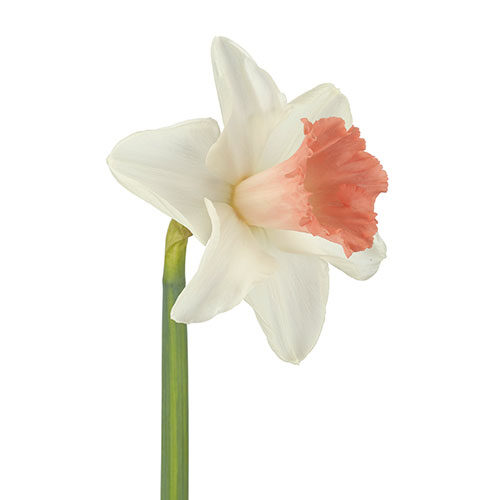 Daffodil Pink Perfection White/PinkShape: Trumpet Daffodil Pink Perfection White/PinkShape: TrumpetVase Life: 5-7 days Petal Count: 6 per bloom Description: A refined variety with white petals and a deep rose-pink trumpet. One of the truest pink daffodils available. | 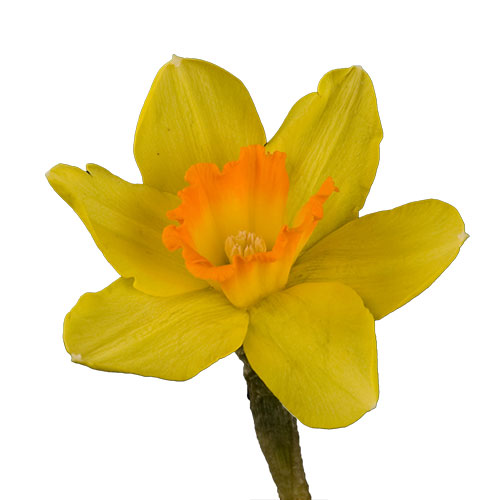 Daffodil Pinza Yellow/OrangeShape: Large-Cupped Daffodil Pinza Yellow/OrangeShape: Large-CuppedVase Life: 5-7 days Petal Count: 6 per bloom Description: The large-cupped Pinza has a wide, deep orange band that fades to golden yellow at the base, surrounded by rich golden-yellow petals. Its slightly reflexed petals make it distinct from other daffodils. | 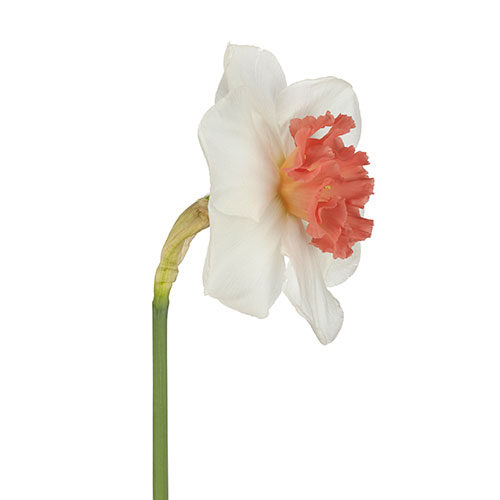 Daffodil Precocious White/PinkShape: Large-Cupped Daffodil Precocious White/PinkShape: Large-CuppedVase Life: 5-7 days Petal Count: 6 per bloom Description: A striking large-cupped daffodil with creamy white petals and a vibrant pinkish-orange trumpet. The ruffled edges add extra texture and beauty. | 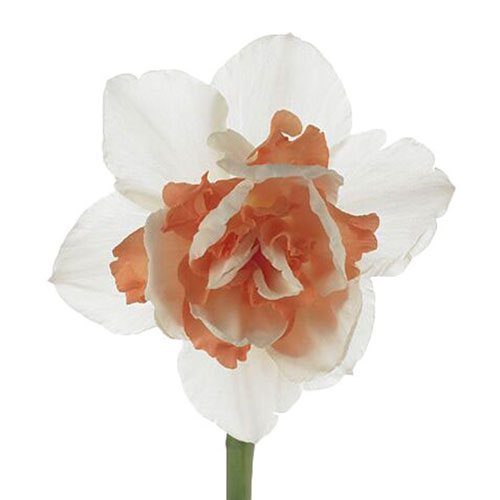 Daffodil Replete White/OrangeShape: Double Daffodil Replete White/OrangeShape: DoubleVase Life: 5-6 days Petal Count: 12+ per bloom Description: A lush double daffodil with layers of ruffled white petals and a coral-orange center, resembling a peony. |
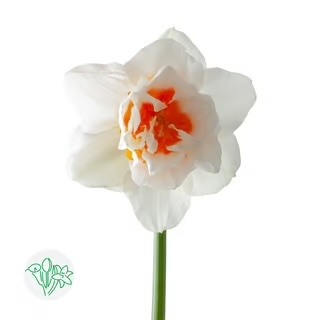 Daffodil Romantic Paradise Cream/OrangeShape: Double Daffodil Romantic Paradise Cream/OrangeShape: DoubleVase Life: 5-6 days Petal Count: 12+ per bloom Description: A pastel-hued double daffodil with creamy outer petals and a gently ruffled apricot-orange cup. | 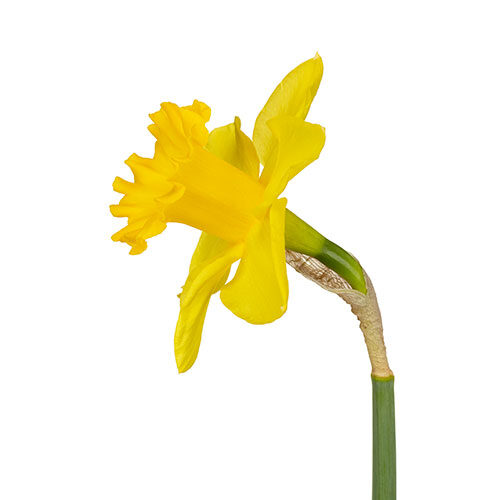 Daffodil Royal Dutch YellowShape: Trumpet Daffodil Royal Dutch YellowShape: TrumpetVase Life: 5-7 days Petal Count: 6 per bloom Description: A bright golden-yellow trumpet daffodil with strong stems. | 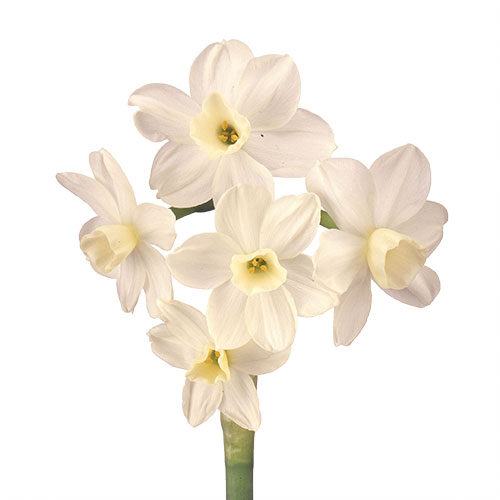 Daffodil Silver Chimes WhiteShape: Tazetta (Cluster-Flowered) Daffodil Silver Chimes WhiteShape: Tazetta (Cluster-Flowered)Vase Life: 7-10 days Petal Count: 6 per bloom Description: A tazetta daffodil with multiple small, pure white flowers per stem and a tiny yellow cup. | 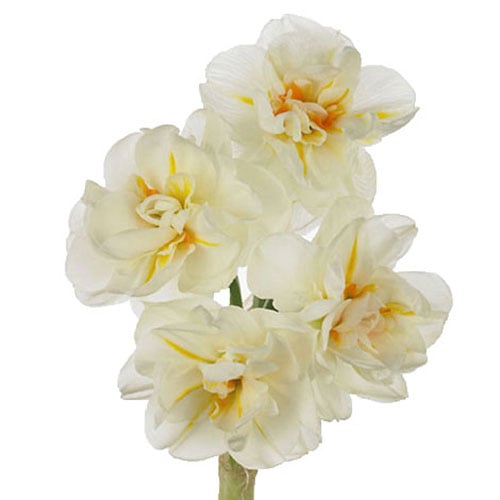 Daffodil Sir Winston Churchill WhiteShape: Double Tazetta (Cluster-Flowered) Daffodil Sir Winston Churchill WhiteShape: Double Tazetta (Cluster-Flowered)Vase Life: 5-6 days Petal Count: 12-18 per bloom (double-layered) Description: A double-petaled tazetta daffodil with clusters of 3-5 exquisite white blooms per stem, flecked with hints of orange-yellow in the center. |
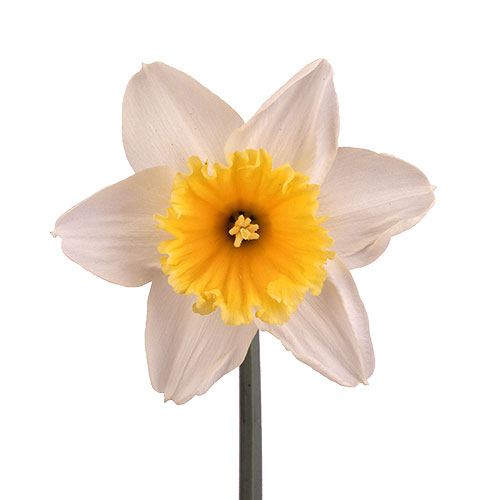 Daffodil Slim Whitman White/YellowShape: Trumpet Daffodil Slim Whitman White/YellowShape: TrumpetVase Life: 5-7 days Petal Count: 6 per bloom Description: A unique bi-color daffodil with crisp white petals and a vibrant yellow trumpet with a slender stem. | 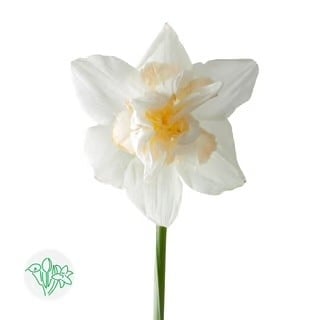 Daffodil Snow Paradise WhiteShape: Double Daffodil Snow Paradise WhiteShape: DoubleVase Life: 5-6 days Petal Count: 12-20 Description: A pristine white double daffodil with elegant, slightly ruffled petals and a soft yellow center. | 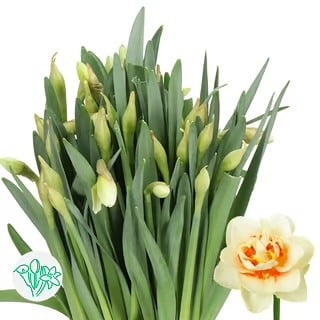 Daffodil Sweet ParadiseShape: Double Daffodil Sweet ParadiseShape: DoubleVase Life: 5-6 days Petal Count: 12-18 Description: A lush double daffodil with creamy white petals and a ruffled peachy-orange center. Its full blooms and delicate fragrance make it a standout in floral arrangements. | 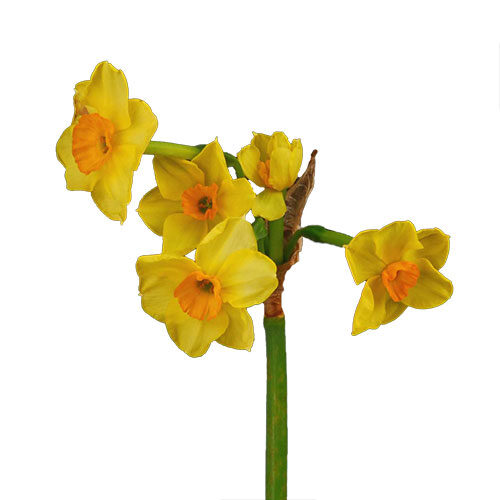 Daffodil Sole D’or YellowShape: Tazetta (Cluster-Flowered) Daffodil Sole D’or YellowShape: Tazetta (Cluster-Flowered)Vase Life: 7-10 days Petal Count: 6 per bloom Description: A multi-flowered tazetta daffodil with 10-20 bright yellow blooms per stem, each surrounding a rich orange cup. |
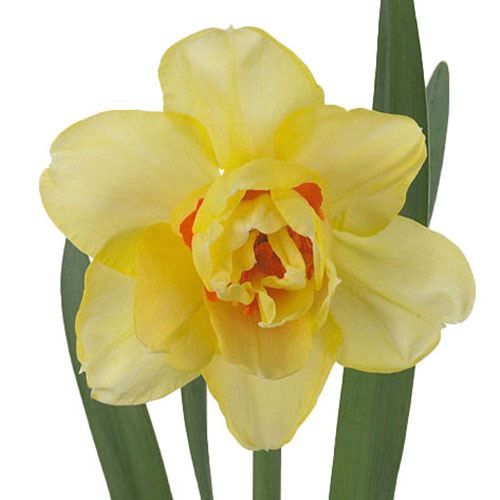 Daffodil Tahiti Yellow/OrangeShape: Double Daffodil Tahiti Yellow/OrangeShape: DoubleVase Life: 5-6 days Petal Count: 12-18 per bloom Description: A striking double daffodil with golden-yellow outer petals and bold orange-red ruffled inner petals. | 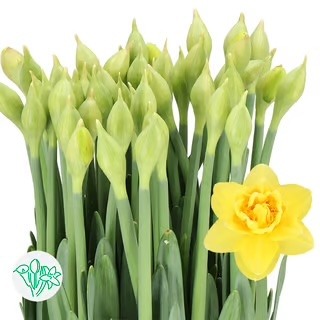 Daffodil VenetoShape: Double Daffodil VenetoShape: DoubleVase Life: 5-6 days Petal Count: 12-18 per bloom Description: A vibrant double daffodil featuring golden-yellow outer petals and a rich, ruffled center in a deeper yellow hue. Its full, textured blooms add volume and depth. | 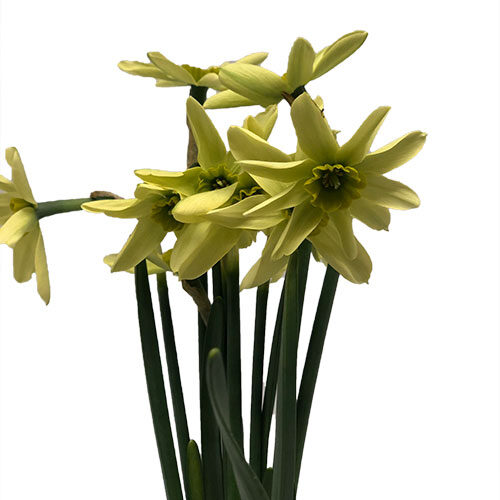 Daffodil Viridiflora Green Light GreenShape: Small Cup Daffodil Viridiflora Green Light GreenShape: Small CupVase Life: 5-7 days Petal Count: 6 per bloom Description: A rare and exotic daffodil with creamy soft green petals. | 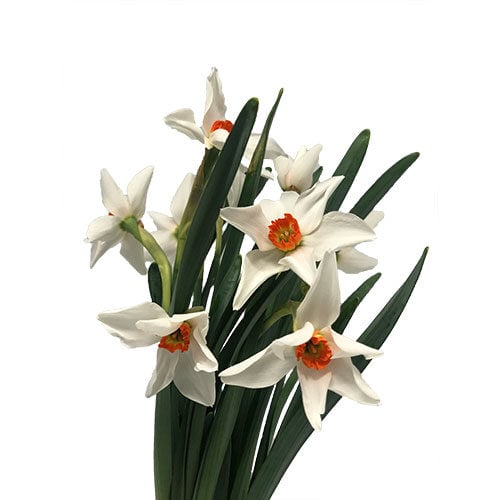 Daffodil Viridiflora Green Orange White/OrangeShape: Small Cup Daffodil Viridiflora Green Orange White/OrangeShape: Small CupVase Life: 5-7 days Petal Count: 6 per bloom Description: A refined daffodil variety with crisp white petals and a bold orange center. |
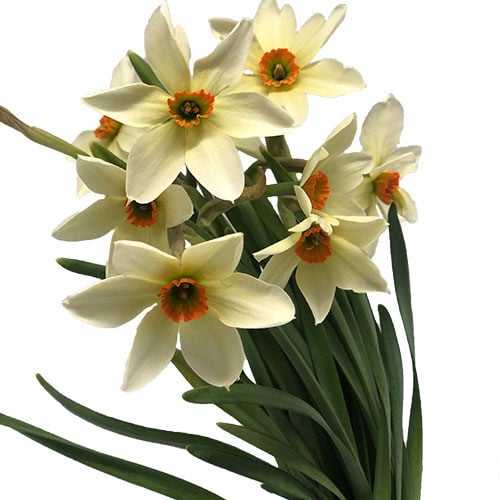 Daffodil Viridiflora Lemon Orange Cream/OrangeShape: Small Cup Daffodil Viridiflora Lemon Orange Cream/OrangeShape: Small CupVase Life: 5-7 days Petal Count: 6 per bloom Description: A distinctive daffodil with lemon-yellow petals and a creamy apricot-orange trumpet. | 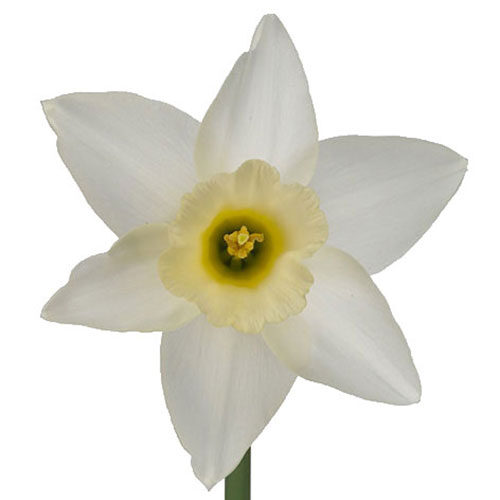 Daffodil Wedding Bell WhiteShape: Trumpet Daffodil Wedding Bell WhiteShape: TrumpetVase Life: 5-7 days Petal Count: 6 per bloom Description: An elegant white daffodil with gently ruffled petals and a soft yellow trumpet. A popular choice for wedding bouquets and spring arrangements. | 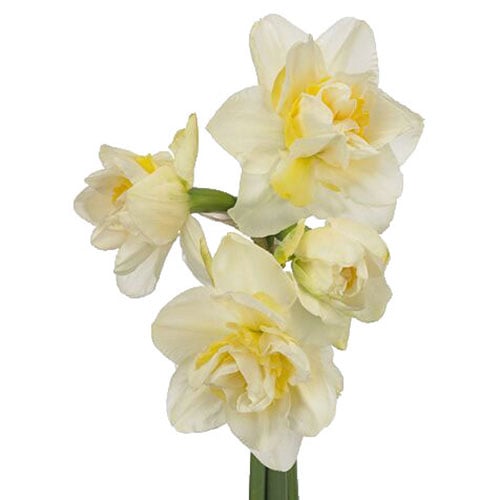 Daffodil White Lion CreamShape: Double Daffodil White Lion CreamShape: DoubleVase Life: 5-6 days Petal Count: Multiple layers per bloom Description: A romantic double daffodil with layers of creamy white petals and subtle hints of soft yellow in the center. | 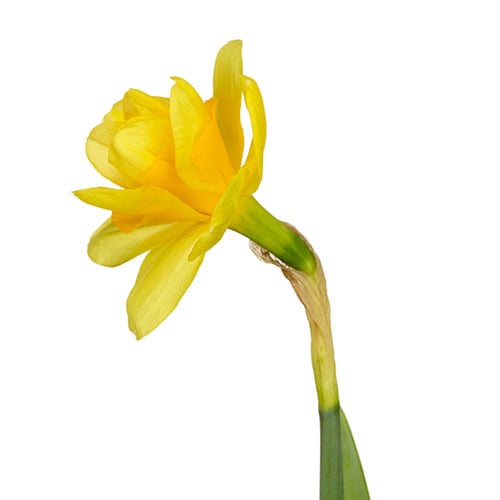 Daffodil Yellow Paradise YellowShape: Double Daffodil Yellow Paradise YellowShape: DoubleVase Life: 5-6 days Petal Count: 12-18 per bloom Description: A vibrant, deep yellow double daffodil with a slightly ruffled edge. Its full, layered petals add texture and brightness to floral designs. |
How to Properly Add Daffodils to an Arrangement with Their Toxic Sap
Daffodils release a toxic, gooey sap when their stems are cut, which can shorten the lifespan of other flowers in mixed arrangements. However, with proper conditioning, you can safely use them alongside other blooms. Follow these steps to prepare daffodils for floral designs:
- Condition Daffodils Separately– After cutting the stems, place daffodils in a separate container of clean, lukewarm water for at least 2-4 hours (ideally overnight). This allows them to release most of their sap before being added to an arrangement.
- Do Not Recut Stems When Mixing with Other Flowers– Once conditioned, do not recut daffodil stems when adding them to a mixed arrangement. Cutting the stems again will cause them to release fresh sap, which can harm other flowers.
- Keep Water Fresh– Daffodils should ideally be placed in a separate vase if possible. If mixing with other flowers, change the water daily to minimize sap buildup.
**Note: Daffodil sap is not typically toxic to humans. However, we recommend using gloves when working with these flowers, as the sap can cause skin irritation. The sap daffodils seep out after cutting is only detrimentally toxic to other flowers.
Best Flowers to Pair with Daffodils
Some flowers are more tolerant of daffodil sap, such as:
Daffodils aren’t just a seasonal staple—they’re a floral powerhouse that deserves a prime spot in every florist’s spring lineup. With this image-rich breakdown, you can confidently choose the perfect daffodils for any event, retail order, or custom floral piece.
Need fresh daffodils for your next order?
Connect with your local Mayesh branch or shop online for the best seasonal selection.


